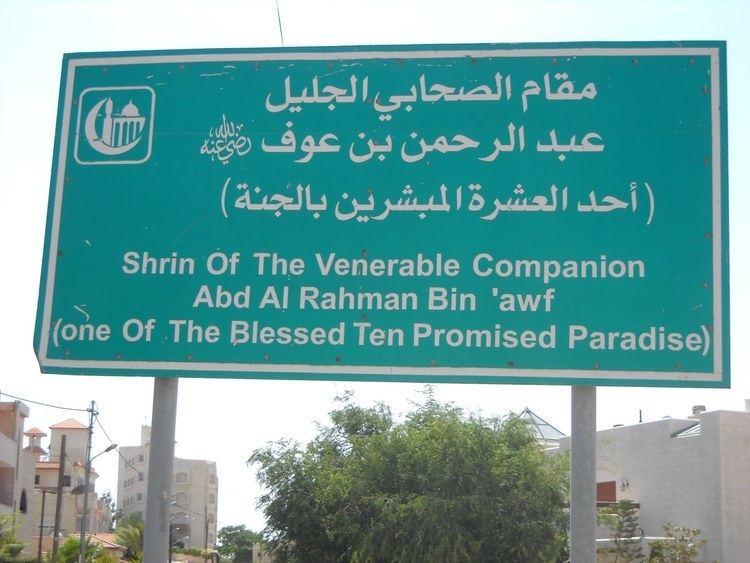Venerated in Islam Name Abdur bin Siblings Al Aswad bin Awf | Influences Muhammad Died 652 AD, Amman, Jordan | |
Spouse Umm Hurayth, Ghazal bint Kisra, Sahla bint Assim Children Abdur Rahman bin Abdur Rahman Parents Ashifa\' bint Awf bin Abd, Awf bin Abd Awf bin Abdul Harith bin Zahra Similar People Zubayr ibn al‑Awam, \'Amr ibn al‑\'As, Zayd ibn Harithah, Abu Hureyrah, Malik ibn Anas | ||
Abdur rahman bin awf and sa d ibn abi waqqas ra mufti menk malaysia ramadan 2014
'Abd al-Rahman ibn 'Awf (Arabic: عبد الرحمن بن عوف) (c. 580 CE – c. 652 CE) was one of the companions of the Islamic prophet Muhammad.
Contents
- Abdur rahman bin awf and sa d ibn abi waqqas ra mufti menk malaysia ramadan 2014
- Name
- Conversion to Islam
- Emigration to Medina
- The Battle of Badr
- Invasion of Dumatul Jandal
- Role in successions to the Caliphate
- Family
- Generosity
- Physical Features
- Death
- Sunni view
- References
Name

His original name was Abdul Amr ("servant of Amr"). It was Muhammad who renamed him 'Abd al-Rahman ("servant of the Most Merciful"). His name has also been transliterated as Abdel Rahman Ibn Auf.
Conversion to Islam

Abu Bakr spoke to 'Abd al-Rahman about Islam, then invited him to meet Muhammad, who heard his declaration of faith and taught him the Islamic prayers. This was before the Muslims had entered the house of Al-Arqam; 'Abd al-Rahman was one of the first eight men to accept Islam.

From about 614 the pagan Quraysh in Mecca "showed their enmity to all those who followed the apostle; every clan which contained Muslims was attacked." The usual threat to Muslim merchants was: "We will boycott your goods and reduce you to beggary."

'Abd al-Rahman was one of a pioneering party of fifteen Muslims who emigrated to Abyssinia in 615. Other Muslims joined them later, forming a group of over a hundred. "They were safely ensconced there and grateful for the protection of the Negus; could serve God without fear, and the Negus had shown them every hospitality." In late 619 or early 620 "they heard that the Meccans had accepted Islam." This probably refers to the Gharaniq episode. 'Abd al-Rahman was one of forty who "set out for the homeland. But when they got near Mecca they learned that the report was false, so that they entered the town under the protection of a citizen or by stealth."
Emigration to Medina
In 622 'Abd al-Rahman joined the general emigration of Muslims to Medina, where he lodged with Saad ibn Al-Rabi until he could re-establish his business.
The Battle of Badr
'Abd al-Rahman was friends with Umayyah ibn Khalaf, a stern opponent of Islam. When 'Abd al-Rahman emigrated to Medina, the two reached a written agreement, according to which 'Abd al-Rahman was to protect Umayyah's property and family in Medina, while Umayyah would protect 'Abd al-Rahman's in Mecca. When 'Abd al-Rahman wanted to sign the document, Umayyah protested, saying "I do not know Ar-Rahman" and requested that the pre-Islamic name "Abdu Amr" should be used, to which 'Abd al-Rahman agreed.

The two met again in the Battle of Badr in March 624.
A narration attributed to Abd-al-Rahman ibn Awf reports:
On the day (of the battle) of Badr, when all the people went to sleep, I went up the hill to protect him. Bilal(1) saw him (i.e. Umaiya) and went to a gathering of Ansar and said, "(Here is) Umaiya bin Khalaf! Woe to me if he escapes!" So, a group of Ansar went out with Bilal to follow us ('Abdur-Rahman and Umaiya). Being afraid that they would catch us, I left Umaiya's son for them to keep them busy but the Ansar killed the son and insisted on following us. Umaiya was a fat man, and when they approached us, I told him to kneel down, and he knelt, and I laid myself on him to protect him, but the Ansar killed him by passing their swords underneath me, and one of them injured my foot with his sword. (The sub narrator said, " 'Abdur-Rahman used to show us the trace of the wound on the back of his foot.")
Invasion of Dumatul-Jandal
In August 626 Muhammad directed 'Abd al-Rahman ibn Awf to raid the Kalb tribe in Daumatul-Jandal, instructing him: “Take it, Ibn Awf; fight everyone in the way of God and kill those who disbelieve in God. Do not be deceitful with the spoil; do not be treacherous, nor mutilate, nor kill children. This is God’s ordinance and the practice of His prophet among you.” Muhammad also instructed him on the correct way to wind a turban. 'Abd al-Rahman defeated the Kalbites and extracted from them their declaration of Islam and the payment of the jizya. He then sealed the alliance by marrying the chief's daughter Tamadur bint Al-Asbagh and bringing her back to Medina.
Role in successions to the Caliphate
In August 634 the dying Caliph Abu Bakr called in 'Abd al-Rahman and Uthman to inform them that he had designated Umar ibn al-Khattab as successor.
In 644, the dying Umar nominated a board of six members (the Council of Shura) to elect one of themselves as the next caliph. The group consisted of Sad Ibn Abi Waqqas, Abd al-Rahman ibn Awf, Zubayr ibn al-Awwam, Talha ibn Ubayd Allah, Ali ibn Abi Talib and Uthman ibn Affan. Uthman was chosen as the third caliph by 'Abd al-Rahman ibn 'Awf.
Family
His sister was married to Bilal Ibn Rabah.
He married at least sixteen times and had over thirty known children.
- Umm Habiba bint Zama'a, a sister of Sawda. No children are known from this marriage.
- Umm Kulthum bint Utba of the Abdshams clan of the Quraysh in Mecca.
- Salim the Elder (died before Islam).
- The Daughter of Shayba ibn Rabia ibn Abdshams.
- Umm Al-Qasim (born before Islam).
- Habiba bint Jahsh of the Asad tribe (childless).
- Tamadir bint Al-Asbagh of the Kalb tribe. Although he divorced her during his final illness, she, like his other three widows, inherited one-thirty-second of his fortune, which was 80,000 or 100,000 dirhams.
- Abdullah the Younger (Abu Salama).
- Umm Kulthum bint Uqba from the Umayya clan of the Quraysh in Mecca.
- Muhammad, from whom he took his kunya of Abu Muhammad.
- Ibrahim.
- Humayd.
- Isma'il.
- Hamida.
- Amat ar-Rahman the Elder.
- Sahla bint Asim from the Baliyy tribe of Medina.
- Maan.
- Umar.
- Zayd.
- Amat ar-Rahman the Younger.
- Bahriya bint Hani of the Shayban tribe.
- Urwa the Elder (killed at Ifriqiya).
- Sahla bint Suhayl of the Amir ibn Luayy clan of the Quraysh.
- Salim the Younger (killed at Ifriqiya).
- Umm Hakim bint Qariz of the Kinana tribe.
- Abu Bakr.
- The Daughter of Abu al-His ibn Rafi from the Abdulashhal ibn Aws tribe of Medina.
- Abdullah (killed during the conquest of Africa)
- Asma bint Salama
- 'Abd al-Rahman.
- Umm Horayth, a war-captive from Bahra
- Mus'ab.
- Amina.
- Maryam.
- Majd bint Yazid from the Himyar tribe.
- Suhyal (Abu'l-Abayd)
- Zaynab bint As-Sabbah.
- Umm Yahya.
- Badiya bint Ghaylan from the Thaqif tribe.
- Juwayriya.
- Ghazzal bint Khosrau (concubine), a war-captive from Al-Mada'in
- Uthman
- Other Concubines (unnamed).
- Urwa.
- Yahya.
- Bilal.
- Saad.
- al-Miswar (died at al-Harra).
- Fakhita, a wife of Yazid ibn Abi Sufyan.
- Umm al-Qasim the Younger, a wife of Yahya ibn Al-Hakam (brother of Marwan I).
- Daughter, a wife of Abdullah ibn Uthman ibn Affan.
- Daughter, a wife of Abdullah ibn Abbas.
Generosity
Many stories are told of 'Abd al-Rahman's personal generosity. He once furnished Muhammad's army with 1,500 camels. He bequeathed 400 dinars to the survivors of Badr and a large legacy to the widows of Muhammad. One day he brought a caravan of 700 merchant camels into Medina. Aisha remarked, "I have heard the Allah's Messenger say: 'I have seen 'Abd al-Rahman ibn Awf entering Paradise leaping.'" This was repeated to 'Abd al-Rahman, who replied: "If I could, I would certainly like to enter Paradise standing. I swear to you, yaa Ammah, that this entire caravan with all its merchandise, I will give in charity." And so he did.
Physical Features
'Abd al-Rahman ibn 'Awf was light in complexion and had lustrous eyes with long eyelashes. He had a convex nose and a long elegant neck. He had somewhat protruding upper teeth and heavy hair under his earlobes. His hands and fingers were thick and masculine. He had curly hair and overall handsome with a good complexion. He had a limp due to the wounds inflicted on him on the day of Uhud.
Death
'Abd al-Rahman died in the Levant (بلاد الشام) in 33 AH (652 CE) during the reign of Uthman. He was buried on a hill to the north-east of present-day Amman, Jordan.
Sunni view
Sunnis regard him as one of the al-asharatu-l mubashshirin, the ten people whom Muhammad personally assured of entering Paradise.
